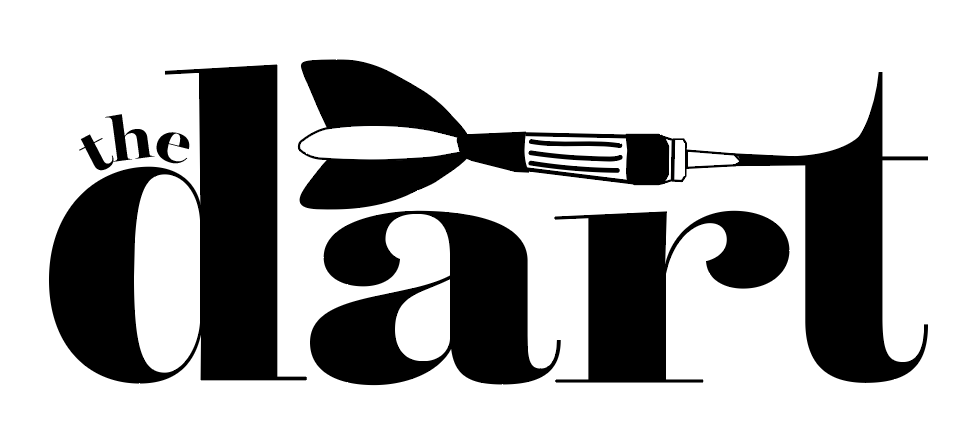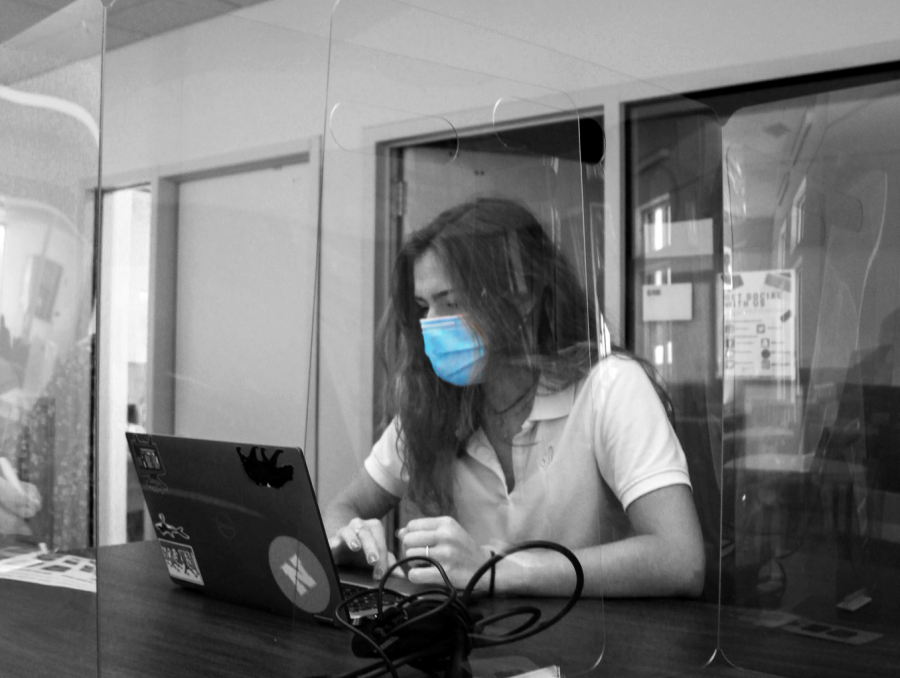The Education Experiment: Reopening Schools in a Pandemic
Students and teachers across Kansas City are going back to school and administrators are trying to make sure they can do it safely. However, the plans for doing so differ from school to school significantly.
Junior Lissette Sessler sits working on her computer during her history class Aug. 28. During class, students are divided by plastic shields that separate each student. photo by Becca Speier
“It was exhausting,” Liz Baker said. “I will not lie. It was like, I mean, if you turn to the calendar, it’s the six month into this pandemic, and for six months that’s all I’ve thought about is COVID-19 and how to keep kids safe.”
Baker is the principal for student affairs at STA and along with the rest of the administration, she has been crafting a reopening plan for the 2020-2021 school year nonstop since March. It was clear to them from the initial surveys sent out to students, parents and teachers that the community wanted to be back in-person. The question, at that point, was just how to accomplish it.
“Can you see this? This is the COVID file,” Baker said, opening a filing cabinet filled to the brim with papers. “We used kind of a matrix and put people in teams to make sure that we were getting every kind of—there’s so much involved in just like maintenance and facilities and academics and the health app and things like that—and just trying to make sure that we were thinking of every little thing.”
The file consisted of everything from documents on how to social distance in the classroom to guidelines for choir performances to rules about how to use a microscope in a chemistry lab.
“It’s just things that you wouldn’t naturally think about in terms of an epidemic or pandemic,” Baker said. “So we took those items, kind of split them up into teams, worked on them quite a bit over the summer and then just started using that research to do actions.”
These actions took shape in the form of markers on the floor guiding students on how to social distance, signs pointing the way to exit the buildings and a presentation for students outlining these procedures during orientation, among countless other measures.
STA detailed three different education plans to their students through an informational packet sent out over the summer: in-person, hybrid or virtual learning. Students were to start the year in person, and a rise in cases would dictate a switch to another plan. Senior Mara Kugler is one of a few students who have been learning virtually since the beginning of the year. She knew she wanted to pursue a virtual option from the moment she learned that STA would be having school primarily in-person.
“I wasn’t surprised, but I wasn’t happy about it,” Kugler said. “I was hoping it wouldn’t go that way because I already knew that it was getting worse in Kansas City, and I didn’t want to be in-person, so I decided to go online.”
Although Kugler had a relatively easy time getting permission to learn online, she thinks the process could have been more accessible for other students.
“Yeah, the only reason I knew about going online is because my sister, her immune system is compromised,” Kugler said. “That’s the only way that I knew I could go online, but I’ve talked to people about it and they don’t really know about the option. It’s not that it’s hard to go online, it wasn’t very obvious that it was an option if that makes sense.”
Principal Barbara McCormick confirmed that the school did not offer a virtual option to the student body at large, but that they did make sure immunocompromised students were accommodated.
Kugler says her experience as a virtual student so far has been mixed, but it has improved significantly since more people have joined the virtual classroom during hybrid learning.
“It’s harder to forget about students online if there’s like five of them than if there’s one,” Kugler said. “Now that [the teachers] have become more accustomed to it and it’s more people online, they pay more attention to us when we have questions so it’s a lot better. Definitely.”
English teacher Kelly Finn has found that teaching virtually is much easier now than it was in the spring because she was able to prepare for this semester and make a virtual learning plan ahead of time.
“I think teachers were allowed to kind of process it over the summer and say, ‘Okay, what are the best practices and what do I want students to sort of get out of this experience?’” Finn said. “So I think that the quality of teaching only increased.”
The biggest challenge Finn has faced so far is teaching a mix of in-person and virtual students in the same class.
“You’re trying to meet the needs of your students in dramatically different environments,” Finn said. “You’ve got your students in-person and technology limitations kind of prevent you from, you know, walking away from your computer. I know that we’re trying to look into some different technology solutions for trying to engage the people who are studying virtually so they can sort of hear better and feel like they’re more present, but I will say that that is the most challenging of the environments because as a teacher, I set really high expectations for myself, and if I feel like I’m not meeting the needs of one of those environments 100%, that’s a struggle.”

In contrast to STA’s reopening plan, Shawnee Mission School District started virtual school Sept. 13. While coming up with a plan for the year, SMSD consulted parents, students and teachers about their preferences for online or in-person learning. While gathering this information, SMSD director of communications David Smith found that the community was very divided.
“We have a strong component of folks who want one thing and a strong component that want another,” Smith said. “So knowing that those groups were polarized, it was clear to us, it didn’t matter what we did. Anything we did would segment the community terribly. It was the worst thing in the world to do.”
Despite current grim conditions, Smith is optimistic about the idea of sending students back to school later in the semester.
“It’s our hope and desire, and you know one of the things that we don’t control but, we wish with all our hearts and minds that the community would take seriously all of the precautions, including wearing masks and social distancing and not having gatherings of kids or adults,” Smith said. “All of those things, so that we might be able to begin bringing our kids back in a hybrid environment within the next month or so.”
As of Sept. 9, SMSD now plans to start transitioning into hybrid learning for elementary students Oct. 5 and have those students be fully in-person by Oct. 23. Middle and high school students will remain remote for the foreseeable future.
In contrast to the SMSD plan, President Shane Foster of the Barstow School has been facilitating in-person learning since Aug. 20. The Pre-K through 12 grade institution is offering three options to parents.
“One is a come to school every day, the second option is a hybrid option… Our hybrid option is: you can come to school in the morning, you can come to school for an hour, and then you can choose to go home” Foster said. “The third option we have is a full stay home option, and
we have some students who are doing that. But again, our option is you don’t have to sign up for one or the other, you can come any day.”
Foster feels that Barstow is ahead of the game on their virtual education style. As a school that conducts learning internationally, they adapted to online learning platforms long before the pandemic.
“We’ve been doing online learning since 2011… so, and I hate to say this in a bragging way, we’re pretty good at it because we’ve had a lot of practice,” Foster said.
Years of preparation opened up new technological opportunities to enhance virtual learning. A device unique to Barstow is the Swivel, which is used to create an in-person classroom experience virtually.
“Basically you just set an iPad straight into it, you have a little device which is no bigger than an Apple TV remote and it just sits on your neck and it tracks you around the room wherever you go and the Swivel moves around,” Foster said. “So you could be at home right now,
Zooming into your lesson, and as the teacher is moving around, or she can give the swivel key to a group, and then you’re riding with them.”
Although Foster believes his school is as prepared as they can be during this time, he recognizes the value of connecting locally to discuss health concerns.
“We’re tracking all of the information in Johnson County and Jackson County, following not only CDC guidelines, but also Children’s Mercy because you know while Kansas City’s got a reasonably large population, we’re not New York City, and we’re not Atlanta, and we’re not Chicago,” Foster said. “It was more important for us to look at what somebody like Children’s Mercy was telling us to do because they’re not only following protocols from CDC, they’re also local.”
Diving into a local health perspective, Dr. Marvia Jones is the violence prevention and Policy Manager at the Kansas City Health Department. Her additional role during this time has been to help develop policy guidelines for reopening during the pandemic response, which she fully recognizes a wide spectrum of needs that must be met.
“I see that we are in a position where everyone is trying to best meet the needs of multiple stakeholders,
” Jones said. “I know those stakeholders include students, it also includes, obviously, our community, parents, as well as teach
ers and other staff… A lot of the schools have been really trying to figure out how to do this safely and meet all of the different needs… I believe that people have been sincerely seeking out data and guidance around the issue.”
Specifically with the issues of schools reopening, Jones believes that there is no one catch-all solution.
“All schools don’t serve all the same students, and we know that there is some nuance in the risk levels of different students,” Jones said. “It is very difficult to give a broad statement about whether all schools should be open or closed, that has been a difficult process, because we do believe that there are measures that can be taken to make any school safer. But if the community transmission in the community is not under control in certain aspects, that will minimize some of the effects taken within the school environment.”
The process of schools reopening acts as an experiment of normalcy—what it will take to proceed with life as it once was. But this can only be achieved through following sanitation techniques religiously.
“What happens in the schools reflects what’s going on in the community,” Jones said. “It is not so much that the school has anything magical about it that creates transmission; it’s that people are already infected, and they are bringing it into the school because of their own day to day engagement. So just continuing to speak to some of those core recommendations about, of course, hand washing, but also just being more consistent in wearing masks when we’re around other people, avoiding crowds. That doesn’t sound fun or sexy, but that’s the basics.”
Alicia Kotarba, the president of Notre Dame de Sion, like Barstow has reopened school in full. But as Jones stated, cracking down on the spread of the virus does not strictly rely on schools’ precautions.
“We’re controlling the spread within the walls of the school,” Kotarba said. “But really what’s going to impact our ability to stay in school is what people are doing outside of school and on the weekends and how they’re following social distancing guidelines.”
Kotarba recognizes the importance of maintaining close connections through the community during this time. However, daily there’s a looming anxiety about what could happen during this unprecedented time.
“I think every day I have concerns and anxieties about this,” Kotarba said. “I just kept coming back to this idea of ‘don’t lose who we are, stay true to Sion’ as we think about the planning of this. So to me, that means a connected, close community and keeping with our traditions, so we’re big on traditions, as I’m sure you all are.”
STA and Sion have more in common than traditions, however. Kotarba and Dr. Siabhan May-Washington have been in discussion for months on how to handle the pandemic.
“All of the area independent schools—the heads of schools and the presidents—typically would get together once a month for lunch when we are in pre-COVID times,” Kotarba said. “…But given just what an interesting, unprecedented time this all was—and we were all facing such similar challenges—throughout all of this spring and the summer, we actually had weekly Zoom calls with all of us to share different topics that were coming up, sharing resources, align on where the others were at with plans for reopening, just so we could use a peer group to rely on and also better understand what the other schools were thinking.”
Baker says that she, along with McCormick and Dr. May-Washington, also consulted heads of other schools in the area and shared ideas about how to keep students safe.
“It’s a lot of back and forth and trying to make sure that we’re all on the same page, especially during summer school because we were all having camps and academic kinds of things,“ Baker said. “There’s a lot of camaraderie about it because it is something that is so important.”
After six days of in-person learning, STA had to switch to hybrid classes for a two week period until the school’s number of cases dropped to below seven. However, Baker is grateful for any time that students and faculty get to spend on campus, even if it becomes limited in the future.
“I feel like the first week went really well in the sense of kids connecting with their friends and being able to be a bit normal again in the midst of all this craziness,” Baker said. “That is really important to kids for their mental health, their physical health and their spiritual well-being. And once we got through that first weekend, it was like, okay whatever happens happens, but having kids be able to connect with their teacher, especially for freshmen, that’s huge.”
As for Baker’s priorities for the semester, she wants to focus on protecting students’ mental and physical health while maintaining a sense of normalcy whenever possible.
“We’re trying to keep that routine and that normalcy for kids so they have that feeling of, ‘Okay, I know what I’m doing. I got it now. I’m powerful. I’m empowered,’ to keep people feeling like they’re not spinning,” Baker said. “It’s hard. When you think about normal, and that this is anything but, it’s hard, but if we can keep it somewhat normal, it’s good.”

Hey reader! My name is Claire Smith and I am the co-Editor-in-Chief of the Dart with Rachel Robinson! This is my third and final year on staff and all...
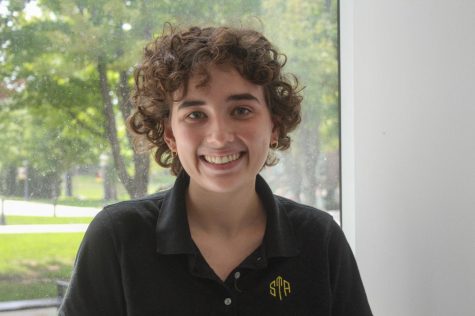
Hi! I’m Rachel Robinson and I am the co-editor-in-chief of the Dart! I’m so excited to spend my last year here leading this incredible staff alongside...
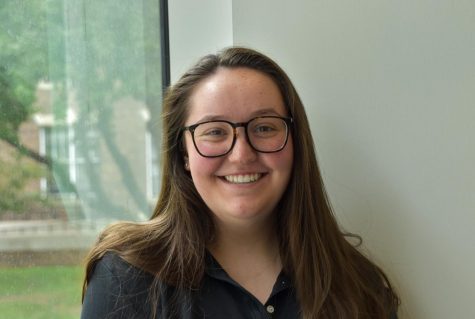
Hello! My name is Grace Ashley, and I am a page designer and the multimedia editor for The Dart! This is my first year on staff, and I am looking forward...
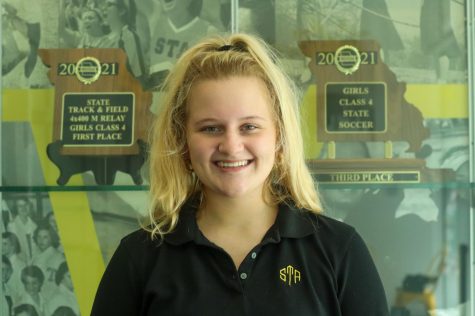
Hello! My name is Becca Speier and this is my third year on the Dart, coming back as one of the three Editors-in-Chief. Some updates in my life: I have...
